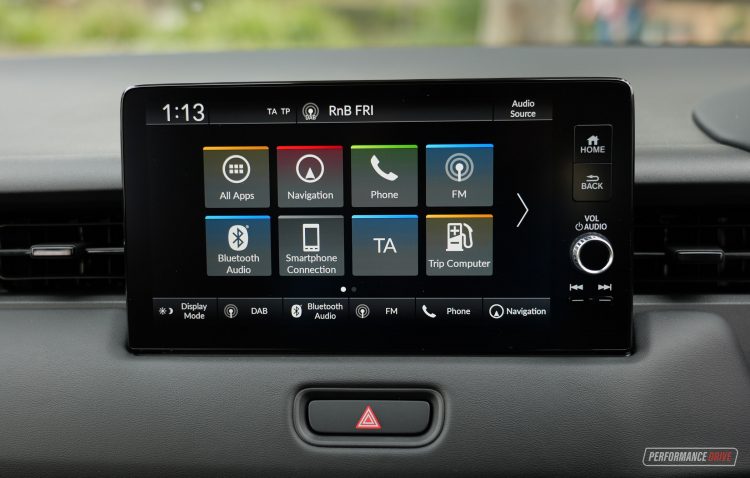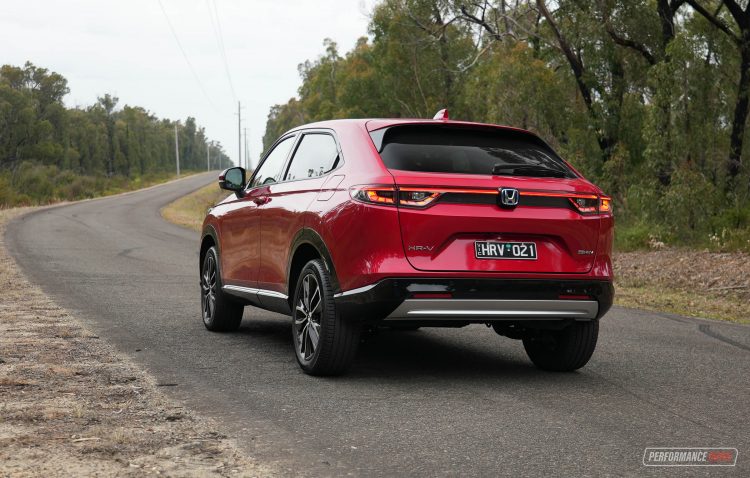Honda has gone rogue. The Japanese carmaker has completely overhauled its pitch, its target market, and its models. One model being the all-new, third generation HR-V small SUV. This time round, it is sold as a premium SUV, and redesigned from the ground up. It also uses the brand’s new direct-to-customer, fixed-price sales model.
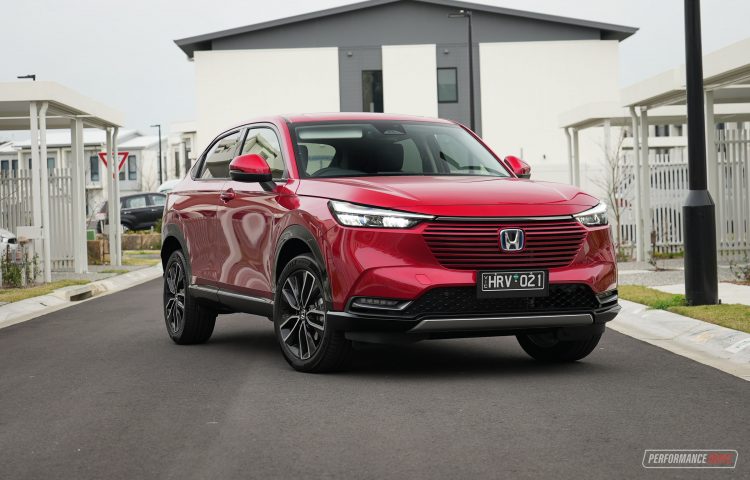
The all-new HR-V shows us how we need to re-frame our thoughts of Honda as a brand. One that no longer makes entry-level cars. You get coupe-inspired premium SUV styling, a practical and elegant interior, a new hybrid engine, and all with a premium price tag to match. Oh, and it’s now a four-seater. What?
Stripped back to just two variants, the Vi X is fitted with a 1.5-litre four-cylinder, naturally aspired petrol engine that produces 89kW and 145Nm. It retails for $36,700. Then there is the lead act we’re testing here, the e:HEV L. It is equipped with the same engine and adds a dual motor AC permanent magnet and battery system. It retails for $47,000 (drive-away).
Both models power the front wheels only via a constantly variable automatic transmission (CVT), with no option for all-wheel drive.
* Figures as tested by PerformanceDrive on the day. Factory claims may be different
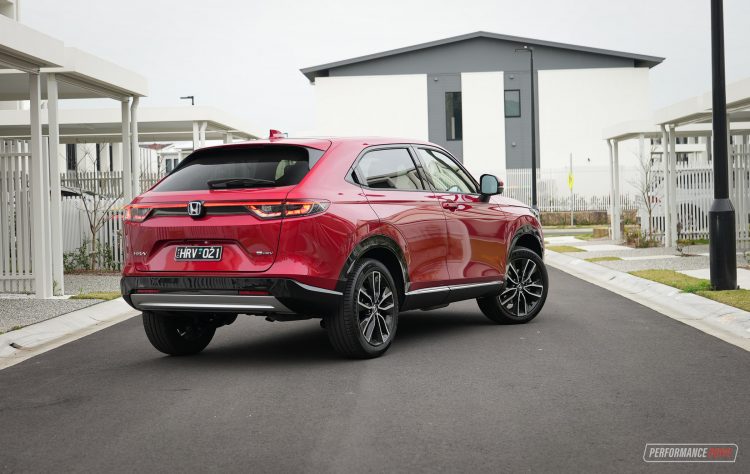 2023 Honda HR-V e-HEV L – THE PACKAGE
2023 Honda HR-V e-HEV L – THE PACKAGE
Upon first glance, you immediately notice the HR-V’s completely new appearance. Compared with the previous model, it stands 25mm shorter in length, 15mm lower in height, and width and track remain the same. But ground clearance has grown by 25mm (to 195mm), helping to give it a more rugged look.
Miles more sophisticated in design, it struts sequential indicator LED lighting and the headlights are sharper as they slope down towards the middle. The front grille is made of straight horizontal body-coloured tiers, and the top chrome line blends in with the LED lights, which give it vibes of premium attention-to-detail.
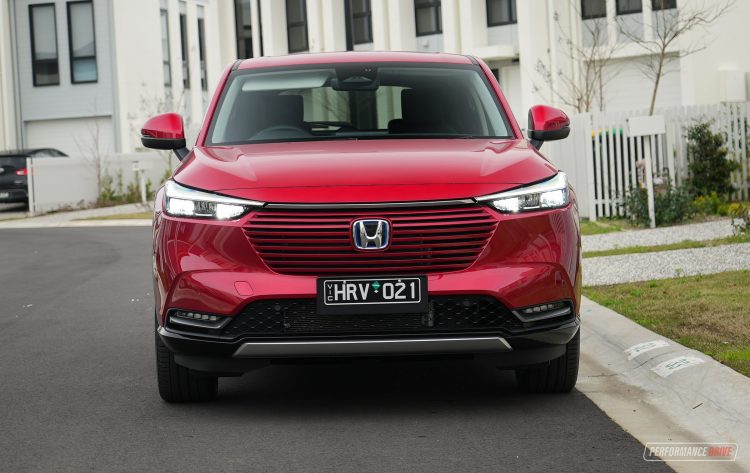
A striking sharp fold trails along the doors to the rear to convey strength and elegance. Then the rear goes with a less rounded, more sloped design with a sharp upper spoiler and LED lighting that takes up the width of the rear. Looking at the side profile, it conveys prestige with large wheel arches and contrasting chrome and black 18-inch alloy wheels. The rear door handles remain camouflaged and vertical high in the door like the previous model. It’s an overall stand-out design that we believe brings it above an entry-level SUV look.
Interior aesthetics are sophisticated, with its minimal, clean and straight-lined appearance. No silly protruding bits of plastic trying to look funky. Just a calm, simple and modern space. There are more soft-touch materials, glossy black areas, and textured chrome knobs that really help to raise that premium feel. Dash air vents blend in behind a long detail strip, and the side vents have a nifty dial you can turn, which moves the flow of the air to the side so it is not blowing into your face.
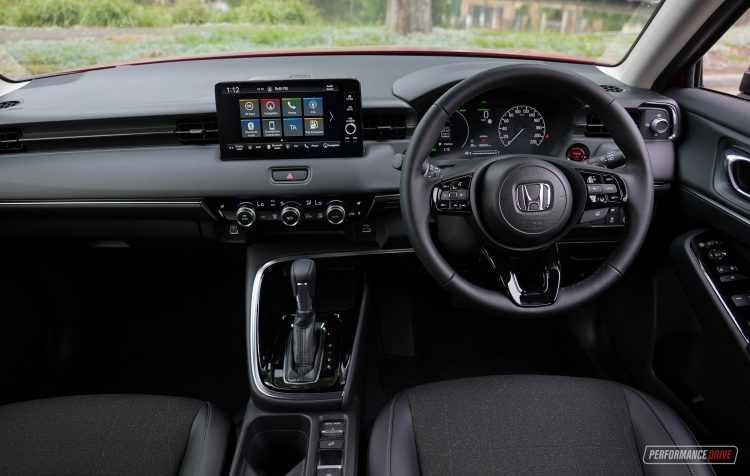
The instrument cluster combines an analogue speedo with a 7.0-inch multi-info display. They both look so similar and blend in so well that you wouldn’t know one side wasn’t digital. To your left is a high resolution 9.0-inch touch-screen that is a breeze to navigate. It connects you to Android Auto, wireless Apple CarPlay, digital radio, sat-nav, Bluetooth, and a six-speaker sound system (only four speakers in the Vi X).
Comfort levels are a big tick with a surprisingly roomy interior for a small SUV. You get plenty of room in the front with impressive leg and head room on offer. Though, the cup holders are too small to fit bottles. The front seats are small-framed, which makes the space feel bigger. But they are still supportive to sit in, and the fabric and leatherette combo used looks and feels premium.
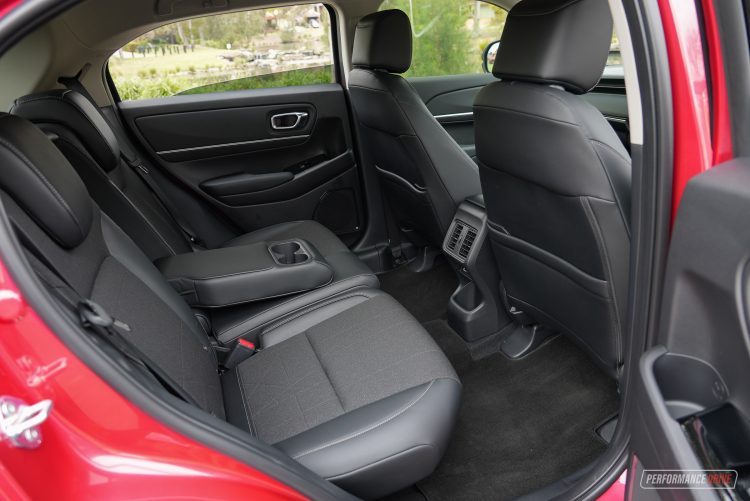
The rear is not neglected either, with rear air vents, USB ports, and plenty of leg room for two adults. Unfortunately, that’s all the rear seat will accommodate – no middle seat is just puzzling to us. We believe such a bizarre choice to make an SUV a four-seater will turn away many potential buyers. On a positive note, Honda’s famous ‘magic’ seats are fitted in the HR-V. It means they can perform manoeuvres like fold the back rest down or pull the bottom of the seat up to reveal the floor and create a higher space to transport taller items, like plants. It is one of the most versatile and practical seat designs on the market.
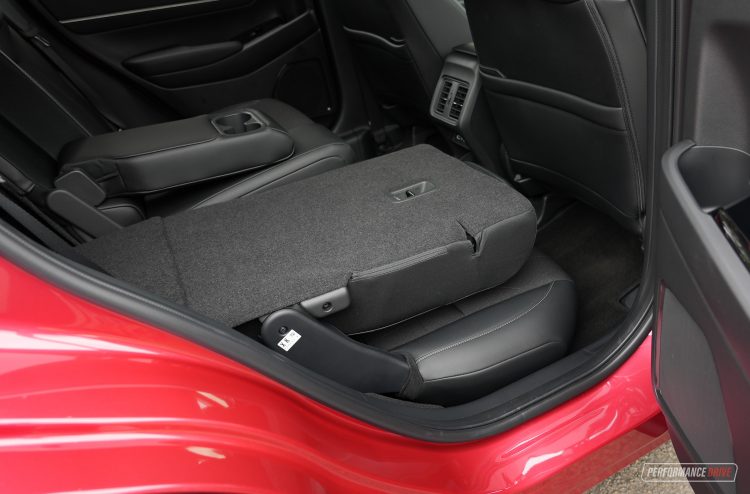
Further back, the boot swallows 304 litres of luggage using the VDA measuring standard. Unfortunately, the boot space race is cheated as no spare tyre is supplied – just a tyre repair kit is offered. Nonetheless, the area is very usable with a wide opening and a low boot lip. In comparison, the Toyota Yaris Cross 2WD fits 390 litres, the Mazda CX-3 measures 264 litres, and the Volkswagen T-Cross squeezes in 385 litres. When the rear seats are folded down (and they fold completely flat), the space opens up to 1274 litres, measuring to the roof.
Both HR-V variants receive a comprehensive list of vital safety technologies as standard that come under the ‘Honda Sensing’ umbrella. They include forward collision mitigation with pedestrian avoidance, lane departure alert and lane keeping aid with steering assist, road departure collision mitigation, auto dipping high beam, traffic sign recognition, and adaptive cruise control with low speed follow alert.
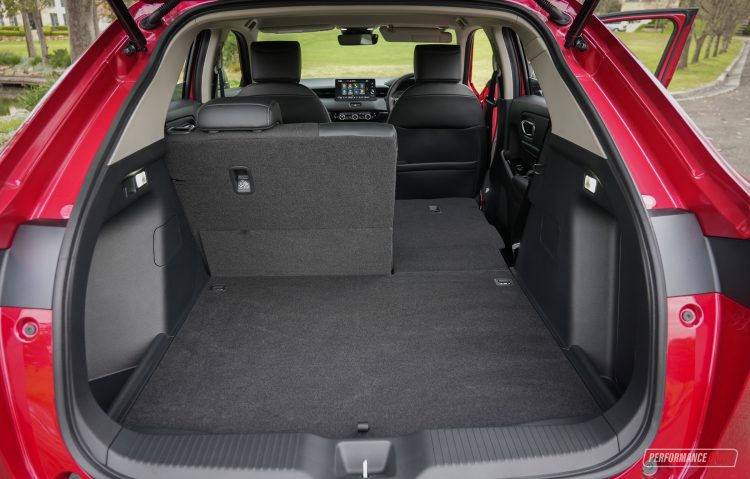
You also score a multi-angle reversing camera, a suite of airbags, tyre pressure monitors, front and rear parking sensors, auto headlights, and key proximity sensors with auto walk away door locking.
Then the e:HEV L adds on the hybrid engine, rear cross-traffic alert, blind-spot monitors, a hands-free powered tailgate with walk away close, heated leather steering wheel, leatherette and fabric seats, heated front seats, auto rain-sensing front wipers, an auto-dimming rear-view mirror, dual-zone climate control with rear air vents, front LED sequential turn signals, LED active cornering and auto-levelling headlights, front LED fog lights, and an acoustic windscreen. Unfortunately, the latest HR-V is rated four stars under ANCAP’s safety analysis.
Honda offers a five-year, unlimited kilometre warranty and five years of free roadside assistance on the HR-V. The warranty on the battery side of the powertrain extends to eight years. Services are required every 10,000km or 12 months, with the first five services costing $199 each.
2023 Honda HR-V e-HEV L – THE DRIVE
The hybrid offering makes the HR-V extra intriguing. The same 1.5-litre naturally aspirated petrol engine is used from the non-hybrid. But it works with a dual motor AC permanent magnet that is powered by a 1.1kWh battery. This is charged via braking energy and cannot be plugged into an external socket. For those nervous about hybrids, it’s absolutely uncomplicated, and you don’t have to drive any differently to an all-petrol SUV.
96kW doesn’t sound like much power, but it is when it is helped along by 253Nm of torque, thanks to the electric side. Working together on the front wheels, the HR-V rolls up to speed in the city (to about 60km/h) effortlessly. It feels particularly light on its feet through the burbs as little exertion is needed in this environment.
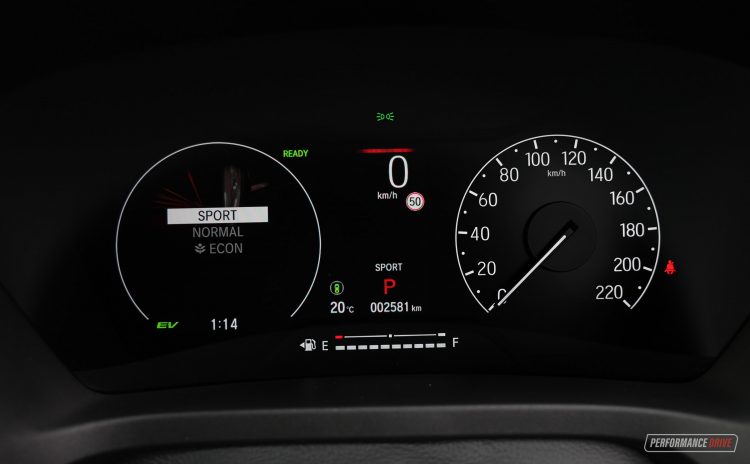
It’s only when you jump onto the highway that it starts to feel lacking. Because less braking and charging is happening on the freeway, the electric side is used less. Then taking over cars or going up hills at or above 100km/h becomes a breathless affair. We tested 0-100km/h in 9.82 seconds using a private road and a Vbox.
The real benefits of the hybrid engine are felt at the petrol station. The official average fuel consumption is rated at 4.3L/100km. Excellent. However, this average is more achievable if your HR-V spends the majority of its time hopping around the city at under 70km/h. Hybrids are vikings in start/stop environments, as the batteries get more of an opportunity to charge, and be used. Our testing revealed a higher average of 5.6L/100km as our travels were made up of more highway speeds than suburban speeds. Still, it’s not a bad score.
Of course, there is the added benefit of lowered CO2 emissions. The official average is 98 grams per kilometre. The non-hybrid engine averages 133 grams per kilometre.
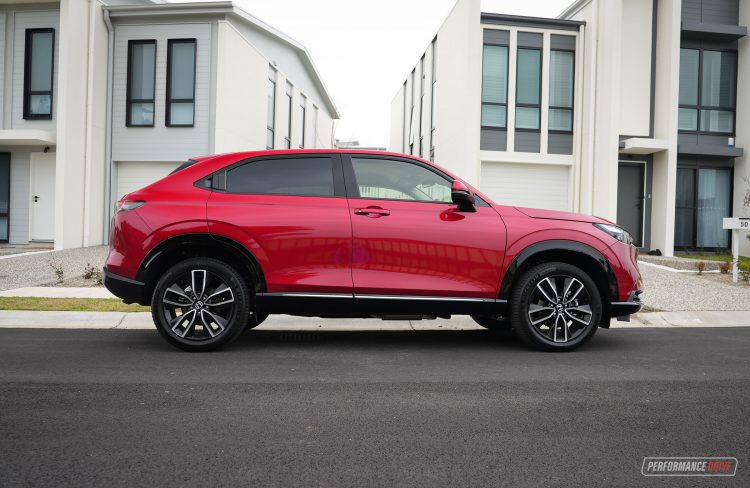
Looking at the rest of the driver experience, the extra suspension travel makes the HR-V brilliant at absorbing bumps and holes in the road. It does a tremendous job at catching the jolts in the shocks rather than in your seat. And even though the rear suspension wears the more inferior torsion-beam setup, it still feels peppy enough to give a supportive and athletic feel around corners. The motion adaptive electric power steering is light in operation for effortless parking, and then heavier at higher speeds, for a more balanced and secure feel.
CVT auto transmissions are not generally our choice of transmission. But for hybrids like the HR-V, it is logical. Aside from the fuel improvements they can offer, this one does well around town with the hybrid setup. Acceleration is smooth and uninterrupted. Only when the engine struggles on the highway the CVT exaggerates the breathlessness occurring as it keeps the engine spinning at the same rate with the same shrill sound.
2023 Honda HR-V e-HEV L – THE VIDEO
We have no doubt that the new HR-V does step it up from the entry-level small SUV it used to be. We think it certainly looks and feels more premium, is loaded with more tech, and the new hybrid engine delivers some fuel reductions. But we’re not sure it quite justifies the hike in price. Remember, it’s only a front-wheel drive, too.
Yes, all car prices have increased, but the sales figures tell a similar story. Usually, a fresh model causes sales numbers to spike. But the HR-V market share between 2022 and 2021 dropped, from 4.9 per cent to 3.8. Sales are also down 22 per cent, according to December VFACTS figures. The elimination of a cheaper ‘base’ model might also be a cause.
And finally, it is now a four-seater. We cannot fathom where or how this limitation could benefit potential buyers. It doesn’t make the SUV more elegant, and it’s not like there is not enough room for a fifth seat belt. What were you thinking, Honda? Are you losing your soul as fast as your models? It does not look good for the Japanese brand in Australia. It has gone from seven models on sale to just four in about one year.
PROS:– Elegant and more premium design than the previous HR-V– Rolls up to speed quickly and effortlessly thanks to its light weight and electric boost– Surprisingly roomy interior for a small SUV– Great on fuel if you zip around at city speeds more– Tight and agile dynamics are admirable; sporty and comfortable at the same time
CONS:– One seatbelt short – only a four-seater!– Another high-priced model that risks killing Honda in Australia– Hills and highway speeds sees the engine struggle and fuel consumption rise– Cruise control needs some refinement– Small cup holders



